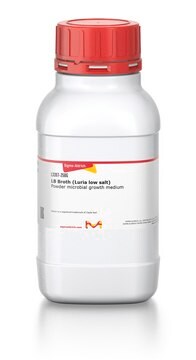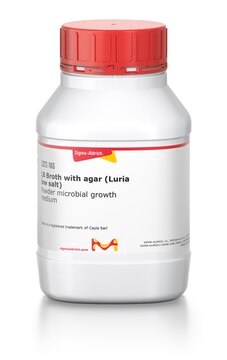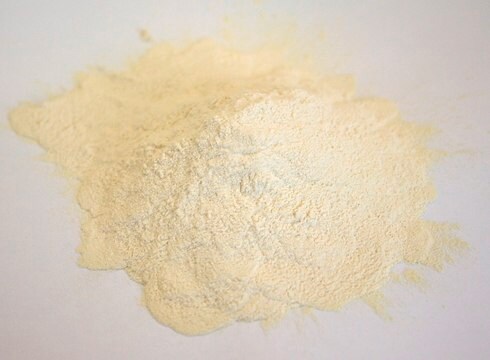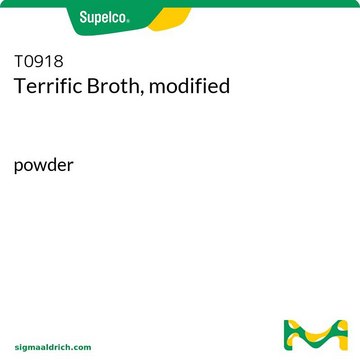L1900
Luria broth base, Miller′s modified
Tryptone, yeast extract and sodium chloride
Synonym(s):
Lennox broth base, modified, Luria-Bertani broth base, modified, Lysogeny broth base, modified
Sign Into View Organizational & Contract Pricing
All Photos(1)
About This Item
UNSPSC Code:
41106200
NACRES:
NA.72
Recommended Products
form
powder
technique(s)
microbiological culture: suitable
application(s)
agriculture
microbiology
General description
Luria broth (LB) is a nutritionally rich bacterial culture medium that is commonly used for maintaining and cultivating laboratory recombinant strains of E. coli. It has potential applications in molecular microbiology methods such as the preparation of plasmid DNA and recombinant proteins. Luria broth base, Miller′s modified is used to culture members of the family Enterobacteriaceae and for coliphage plaque assays.
Application
Luria broth base, Miller′s modified has been used as a nutrient culture medium for E-coli cells.
Luria broth base (LB), Miller (L1900) is a bacteria growth mixture of sodium chloride (0.5g/L); tryptone (10g/L) and yeast extract (5g/L) typically combined with agar (15g/L).
Luria broth base (LB), Miller (L1900) is a bacteria growth mixture of sodium chloride (0.5g/L); tryptone (10g/L) and yeast extract (5g/L) typically combined with agar (15g/L).
Components
Contains: Tryptone, yeast extract and sodium chloride.
Reconstitution
Recommended use at 15.5 g per liter.
Storage Class Code
10 - Combustible liquids
WGK
WGK 3
Flash Point(F)
Not applicable
Flash Point(C)
Not applicable
Choose from one of the most recent versions:
Already Own This Product?
Find documentation for the products that you have recently purchased in the Document Library.
Customers Also Viewed
Erik Benson et al.
Nature, 523(7561), 441-444 (2015-07-24)
It was suggested more than thirty years ago that Watson-Crick base pairing might be used for the rational design of nanometre-scale structures from nucleic acids. Since then, and especially since the introduction of the origami technique, DNA nanotechnology has enabled
Xiaoyun Qiu et al.
Applied and environmental microbiology, 70(11), 6435-6443 (2004-11-06)
We systematically investigated the physiological response as well as DNA damage repair and damage tolerance in Shewanella oneidensis MR-1 following UVC, UVB, UVA, and solar light exposure. MR-1 showed the highest UVC sensitivity among Shewanella strains examined, with D37 and
C Niu et al.
Applied and environmental microbiology, 70(12), 6951-6956 (2004-12-03)
The specific biofilm formation (SBF) assay, a technique based on crystal violet staining, was developed to locate plant essential oils and their components that affect biofilm formation. SBF analysis determined that cinnamon, cassia, and citronella oils differentially affected growth-normalized biofilm
Anthony S Danko et al.
Applied and environmental microbiology, 70(10), 6092-6097 (2004-10-07)
Pseudomonas putida strain AJ and Ochrobactrum strain TD were isolated from hazardous waste sites based on their ability to use vinyl chloride (VC) as the sole source of carbon and energy under aerobic conditions. Strains AJ and TD also use
Daria Julkowska et al.
Journal of bacteriology, 187(1), 65-76 (2004-12-17)
The natural wild-type Bacillus subtilis strain 3610 swarms rapidly on the synthetic B medium in symmetrical concentric waves of branched dendritic patterns. In a comparison of the behavior of the laboratory strain 168 (trp) on different media with that of
Our team of scientists has experience in all areas of research including Life Science, Material Science, Chemical Synthesis, Chromatography, Analytical and many others.
Contact Technical Service













